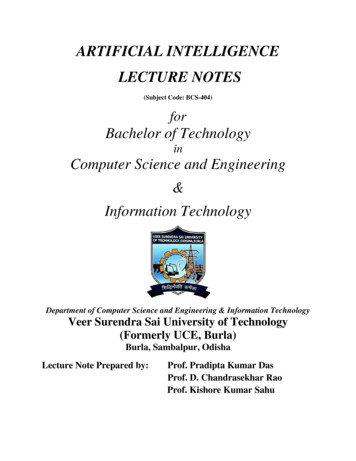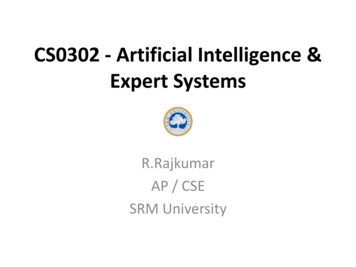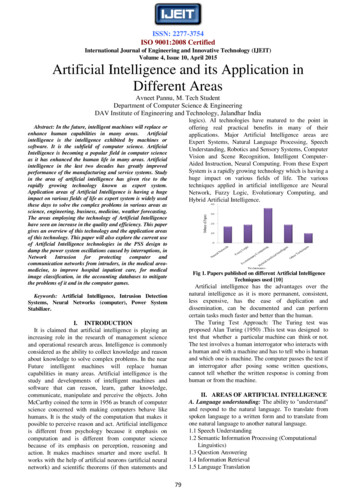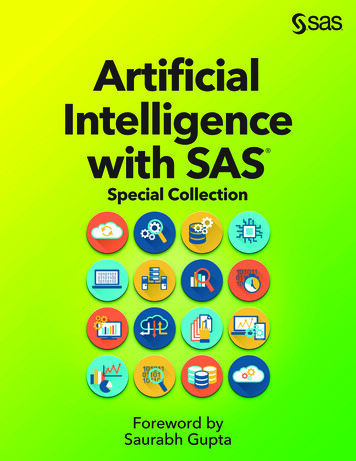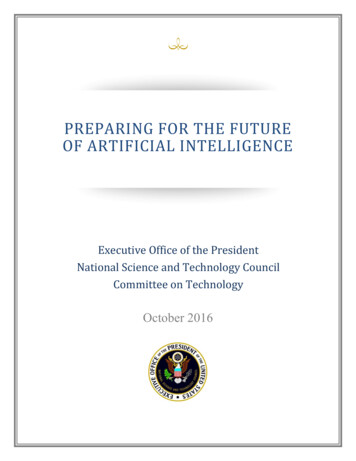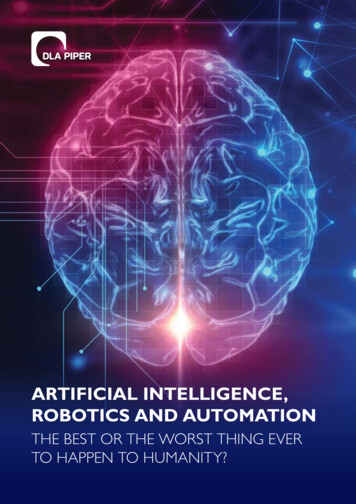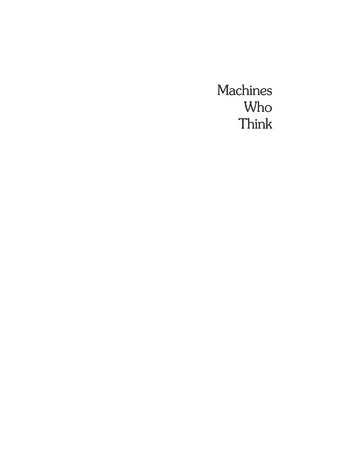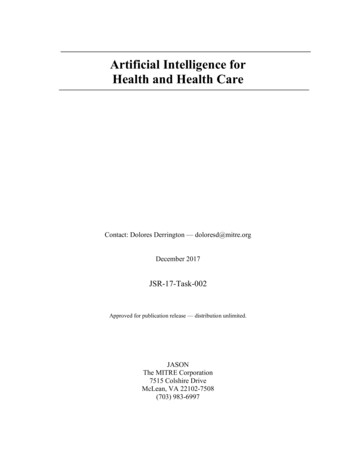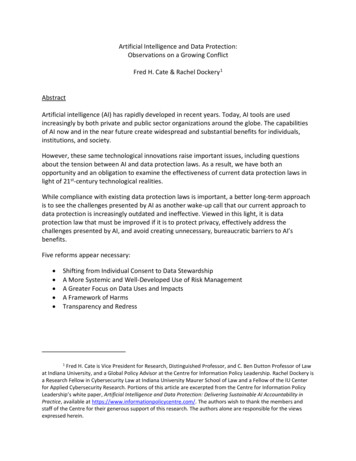
Transcription
Artificial Intelligence and Data Protection:Observations on a Growing ConflictFred H. Cate & Rachel Dockery 1AbstractArtificial intelligence (AI) has rapidly developed in recent years. Today, AI tools are usedincreasingly by both private and public sector organizations around the globe. The capabilitiesof AI now and in the near future create widespread and substantial benefits for individuals,institutions, and society.However, these same technological innovations raise important issues, including questionsabout the tension between AI and data protection laws. As a result, we have both anopportunity and an obligation to examine the effectiveness of current data protection laws inlight of 21st-century technological realities.While compliance with existing data protection laws is important, a better long-term approachis to see the challenges presented by AI as another wake-up call that our current approach todata protection is increasingly outdated and ineffective. Viewed in this light, it is dataprotection law that must be improved if it is to protect privacy, effectively address thechallenges presented by AI, and avoid creating unnecessary, bureaucratic barriers to AI’sbenefits.Five reforms appear necessary: Shifting from Individual Consent to Data StewardshipA More Systemic and Well-Developed Use of Risk ManagementA Greater Focus on Data Uses and ImpactsA Framework of HarmsTransparency and RedressFred H. Cate is Vice President for Research, Distinguished Professor, and C. Ben Dutton Professor of Lawat Indiana University, and a Global Policy Advisor at the Centre for Information Policy Leadership. Rachel Dockery isa Research Fellow in Cybersecurity Law at Indiana University Maurer School of Law and a Fellow of the IU Centerfor Applied Cybersecurity Research. Portions of this article are excerpted from the Centre for Information PolicyLeadership’s white paper, Artificial Intelligence and Data Protection: Delivering Sustainable AI Accountability inPractice, available at https://www.informationpolicycentre.com/. The authors wish to thank the members andstaff of the Centre for their generous support of this research. The authors alone are responsible for the viewsexpressed herein.1
I. IntroductionArtificial intelligence (AI) has rapidly developed in recent years. Today, AI tools are usedincreasingly by both private and public sector organizations around the globe. The capabilitiesof AI now and in the near future create widespread and substantial benefits for individuals,institutions, and society.However, these same technological innovations raise important issues, including questionsabout the tension between AI and data protection laws. As a result, we have both anopportunity and an obligation to examine the effectiveness of current data protection laws inlight of 21st-century technological realities. We need data protection laws and practices thatprotect privacy effectively in an era of AI and the big data on which it often depends, but thatalso do not impose unnecessary roadblocks for the future development of these innovativetechnologies. As repeated government and regulators’ reports have stressed, it cannot be achoice between the already routine benefits of AI and the protection of personal data: we mustfind practical ways of ensuring both.This article introduces AI and some of the applications enabled by it, as well as some of thechallenges and tensions between AI and existing data protection laws and principles. It seeks toprovide a more nuanced understanding of those applications and argues that their interactionwith data protection laws necessitates, and provides a welcome opportunity for, revising thoselaws to reflect 21st-century technological realities.II. Introduction to Artificial IntelligenceA. Defining Artificial IntelligenceThe term “artificial intelligence” (AI) describes the broad goal of empowering “computersystems to perform tasks that normally require human intelligence, such as visual perception,speech recognition, decision-making, and translation between languages.” 2 This one termencompasses a wide variety of technical innovations, each of which may present distinctchallenges to existing data protection tools.Most AI in use today involves computer systems that perform discrete tasks—for example,playing games, recognizing images, or verifying identity—by identifying patterns in largeamounts of data. The mathematical concept of AI dates back to the 1950s but has found real-English Oxford Living Dictionaries, “Artificial Intelligence,” available ificial intelligence.22
world applications in recent years due to advances in processing power and the vast amountsof digital data available for analysis. As a result, AI usually is associated with “big data.” 3We have witnessed many examples of “narrow” AI—AI designed to perform one task or set oftasks. Narrow AI is still complicated. As the New York Times noted, even narrow AI tools can be“bafflingly opaque” and “evade understanding because they involve an avalanche of statisticalprobability.” 4 More challenging are concerns about “artificial general Intelligence.” These are“notional future AI system[s] that exhibit apparently intelligent behavior at least as advanced asa person across the full range of cognitive tasks.” 5 When a system can behave in such a waythat an observer could not distinguish it from that of a human, it is said to pass the so-called“Turing Test,” set out by Alan Turing in 1950.Collectively, these technologies increasingly describe the reality of modern computing, andnations around the globe have showcased a commitment to be at the forefront of AI with theannouncement of ambitious agendas to promote the development of AI technologies. As theEuropean Commission noted in its recent report Artificial Intelligence for Europe: “Artificialintelligence (AI) is already part of our lives—it is not science fiction. From using a virtualpersonal assistant to organise our working day, to travelling in a self-driving vehicle, to ourphones suggesting songs or restaurants that we might like, AI is a reality.” The report goes on tonote the important fact that “[b]eyond making our lives easier, AI is helping us to solve some ofthe world's biggest challenges: from treating chronic diseases or reducing fatality rates in trafficaccidents to fighting climate change or anticipating cybersecurity threats.” 6AI and related technologies are rapidly advancing. “Like the steam engine or electricity in thepast, AI is transforming our world, our society and our industry.” 7 Thus, as the term is usedbelow, AI encompasses narrow AI, which is widely used today and has been used for manyyears, as well as other digital technologies that are ushering in a future of computers sointegrated into daily life that we no longer think of them as computers at all.Some recent applications of AI, such as the use of AI to defeat CAPTCHA and Google’s AlphaGoZeros thattaught itself to play Go at the championship level, have occurred with minimal training data, suggesting that AImay not always be linked to big data.4Kuang, C., “Can A.I. Be Taught to Explain Itself?,” New York Times Magazine (21 Nov. 2017), available ai-be-taught-to-explain-itself.html? r 0.5Executive Office of the President of the United States, National Science and Technology CouncilCommittee on Technology, Preparing for the Future of Artificial Intelligence (Oct. 2016), available lt/files/whitehouse files/microsites/ostp/NSTC/preparing forthe future of ai.pdf.6Communication from the Commission, Artificial Intelligence for Europe, COM (2018) 237 final, availableat http://ec.europa.eu/newsroom/dae/document.cfm?doc id 51625.7Id.33
B. Capabilities of Artificial Intelligence“Machine learning” is a subset of AI that Stanford University professor Andrew Ng has definedas “the science of getting computers to act without being explicitly programmed.” 8 While theterms machine learning and AI are often used interchangeably, machine learning is moreaccurately understood as one method to achieve AI. Machine learning uses statisticaltechniques to give computers the ability to “learn”—to progressively improve the machine’sperformance by creating new mathematical algorithms—from large volumes of data withoutbeing explicitly programmed. Rather than simply following instructions, as traditionalcomputers do, machine learning makes predictions and recommendations based on patternsdetected in training data sets.Machine learning is the basis of other tools, some of which are described below, and it is widelyused today to perform numerous tasks, including fraud detection, email filtering, detectingcyberthreats such as network intruders or malicious insiders, recommending books or movies,or providing other services based on past or anomalous behavior. Machine learning is thetechnology behind Cue, Toyota’s robotic basketball player that has perfect accuracy shooting abasketball and outperforms NBA greats. 9Deep learning is a type of machine learning, inspired by the neural networks of the human brainto process hidden layers of information and arrive at a conclusion. Deep learning uses multiplelayers of artificial neural networks to simulate decision-making of a human. This technology isat the heart of many AI applications developed today, and enables technologies such ascomputer vision, text classification, pattern recognition, speech understanding, and predictiverecommendations. Deep learning has made it possible to have voice recognition technologiesthroughout our daily lives—in smartphones, digital assistants, AI-powered home securitysystems, and other smart devices. Often, deep learning uses larger data sets to create largermodels and optimally train those models.Deep learning has enabled a rise in the technology known as computer vision, where machinesskilled at image recognition, comparison, and pattern identification “see” with equal or fargreater acuity than human eyes, and then connect what they see with previously examineddata. Computer vision has created advances in health care, national security, assistive care, andother various sectors. For example, in health care, algorithms today are able to assess the riskof heart disease in patients by analyzing blood vessels in a retina scan; detect cancerous tumorsMachine Learning, Coursera, available at mparo, A., This basketball-playing robot is so good it could outshoot Stephen Curry, nbcnews.com (20Mar. 2018), available at -ncna858011.894
by examining CT scans; diagnose pneumonia by examining chest x-rays; and identify adult-onsetdiabetes by looking for patterns of retina damage. 10Another application of computer vision is helping visually-impaired individuals understandimages or better perceive their environment by describing them as text, or helping hearingimpaired individuals communicate by translating spoken words to text on a screen.11 Perhapsthe most common day-to-day application of computer vision is facial recognition, which is usedto unlock smart phones, tag pictures of friends on social media, and search images. Computervision has also proven its use in sports, as auto racing uses it to improve driver safety; golf usesit to improve player experiences and analysis; and as the International Gymnastics Federationplans to incorporate it in the Tokyo Olympics of 2020 to assist judges.12Another form of AI technology, Natural Language Processing (NLP) does exactly as the namesuggests—interprets and interacts with real-time dialogue. The goal of NLP, which is oftencombined with speech recognition technologies, is to interact with individuals throughdialogue, either reacting to prompts or providing real-time translation among languages. Thistechnology underpins many customer service transactions, as chatbots are often the first line ofservice. Microsoft’s AI translator is capable of translating Chinese into English with “accuracycomparable to that of a bilingual person.” 13 These translators have numerous applicationsspanning across sectors, geographical boundaries, and cultural barriers. Major news mediahave relied on NLP-based technologies to generate thousands of news, sports, and financialstories over the past two years, including more than 500 reports in the Washington Post aboutthe 2017 elections. 14 Additionally, the GRE exams used for admission to graduate study in manydisciplines are graded today by NLP systems. 15NLP and computer vision are not the only subsets of AI technologies that are drivingadvancements in the field, but these are often the two that underpin other applications of AI.Timmer, J., AI trained to spot heart disease risks using retina scan, arstechnica.com (24 Feb. 2018),available at Seeing AI App, Microsoft Accessibility Blog (12 July 2017), available s-app-store/;Zee, S., Whose Sign Is It Anyway? AI Translates Sign Language Into Text, blogs.nvidia.com (11 May 2017), availableat ates-sign-language/.12Greenberg, N., “PGA Tour Is Embracing Artificial Intelligence, And It Could Change How You WatchGolf,” The Roanoke Times (8 July 2018), available at uld-change/article f46d97b1-0b99-5495-a9e9-a015d0b9620b.html.13Del Bello, L., AI Translates News Just as Well as a Human Would, futurism.com (16 Mar. 2018), availableat ohane, J., “What News-Writing Bots Mean for the Future of Journalism,” Wired (16 Jan. 2017),available at ory/.15Hardesty, L., “Is MIT Giving Away the Farm?,” MIT Technology Review (21 Aug. 2012), available -giving-away-the-farm/.105
For example, robotics combines computer vision, NLP, and other technologies to train robots to“interact with the world around it in generalizable and predictable ways, facilitatemanipulation of objects in interactive environments, and interact with people.” 16 Robots arebeginning to assist in health care, at-home care for the sick or elderly, and other assistivepurposes. In surgeries, robotics technology helps surgeons achieve greater precision andaccuracy.While AI is often perceived as systems acting autonomously, as is the case with home roboticsor self-driving vehicles, most practical applications of AI augment human intelligence, serving ashelpful resources in various professions and automating routine tasks. AI can augment humanintelligence by assisting professionals in decision-making, resource management, safetyinspection, and time management. For example, AI in hospitals is used to suggest diagnosesand treatments to health professionals. In resource allocation, AI is becoming essential fordetermining truck or airline routes and managing deployment of law enforcement resources. Toassist safety inspectors, Intel has developed a technology to help oil rig inspectors protectagainst corrosion by using AI to identify and detect bolt corrosion levels and the potential needfor replacement. Finally, because AI has proved both efficient and effective at issue-spotting inlegal contracts, it is used to assist lawyers, shortening the length of time it takes to perform atask, freeing up time to spend on other tasks, and ideally lowering legal costs. 17 AI is also usedto help judges calculate criminal sentences. Scholars have estimated that as many as one in fiveworkers will have an AI acting as a coworker by 2022. 18C. Public and Private Uses of Artificial IntelligenceThe remarkable developments in AI applications have led to considerable use of AI in public andprivate sectors. As the UK House of Lords noted in its recent AI report, “AI is a tool which isalready deeply embedded in our lives.” 19 As a computational tool that can enhance anydecision-making process, AI enables subject matter experts in every sector to deliver improvedservices and make unprecedented breakthroughs. AI technologies facilitate commercialinteractions and personalized services and products, a trend that is highly demanded byconsumers and citizens. Personalization occurs in the private sector through travel16Stone, P., et al, "Artificial Intelligence and Life in 2030." One Hundred Year Study on ArtificialIntelligence: Report of the 2015-2016 Study Panel, Stanford University (Sep. s/ai100report10032016fnl singles.pdf.17Chin, M., An AI just beat top lawyers at their own game, Mashable (26 Feb. 2018), available mp.18Meister, J., AI Plus Human Intelligence Is The Future of Work, Forbes (11 Jan. 2018), available ork/#789369cf2bba.19House of Lords Select Committee in Artificial Intelligence, AI in the UK: Ready, Willing and Able?, HLPaper 100 (2018), available at elect/ldai/100/100.pdf.6
management, shopper recommendations, and targeted advertising, as well as for societaladvancements in medical diagnosis and treatment, personalized education, and efficient use ofresources. The benefits of AI span across a multitude of sectors, some of which are describedbelow. AI in Health and Medicine—AI in health care is assisting with research and prevention ofdiseases as well as diagnosis and treatment of patients. Intel’s Collaborative CancerCloud is designed to help researchers discover new biomarkers associated with cancerdiagnoses and progression. 20 AI is increasingly used for applications in the practice ofmedicine—whether that is helping doctors find the right location to operate duringsurgical procedures or scanning images for early disease detection. 21 AI-equipped“robots can analyze data from pre-op medical records to guide a surgeon's instrumentduring surgery, which can lead to a 21% reduction in a patient's hospital stay.” 22 Apartnership between the Cleveland Clinic and IBM uses IBM’s Watson to mine big dataand help physicians develop more effective and personalized treatment plans. 23Microsoft’s Project Premonition “aims to detect pathogens before they causeoutbreaks—by turning mosquitoes into devices that collect data from animals in theenvironment.” 24 Microsoft is developing drones that autonomously find mosquitohotspots; deploying robots to collect them; and using “cloud-scale genomics andmachine learning algorithms to search for pathogens.” 25 AI in Transportation—Many modern vehicles include AI technologies that provideassistance when backing up or changing lanes. These tools are found on trains, ships,and airplanes as well—almost anything that moves. Wholly autonomous vehicles havealso increasingly become a reality, with more than 10 million miles logged on publicstreets by driverless vehicles designed to react to changing road conditions and trafficpatterns. These sensor-enabled vehicles are transforming transportation and promisingdramatic changes in vehicle safety, private vehicle ownership, and public transportation. AI in Financial Services—AI is essential for fraud detection and prevention and is beingused by financial service organizations and financial technology firms, including banks,Artificial Intelligence, The Public Policy Opportunity, Intel (18 Oct. 2017), available er-2017.pdf.21Project InnerEye—Medical Imaging AI to Empower Clinicians, Microsoft Project InnerEye (7 Oct. 2008),available at edical-image-analysis/.22Marr, B., “How Is AI Used In Healthcare—5 Powerful Real-World Examples That Show The LatestAdvances,” Forbes (27 Jun. 2018), available at 5dfb.23Id.24Project Premonition aims to detect pathogens before they cause outbreaks, Microsoft ProjectPremonition (2 Mar. 2015), available at rojectpremonition/#.25Id.207
credit card, and other payment service providers, to combat fraud and financial crime. Itis used widely today to identify patterns of normal and unusual behaviors, spot earlyindicators of fraud, enable faster and more accurate financial decisions, and providefinancial service professionals with key information meaningfully integrated from avariety of sources. AI in Marketing—AI has proven useful in more efficient and effective marketing, helpingcompanies produce targeted ads to consumers most likely to be interested in specificproducts (and, conversely, not burdening consumers with ads for products for whichthey have no interest). Popular technology companies such as Amazon, Netflix, andSpotify, as well as traditional retailers such as Starbucks use AI to tailor consumeradvertisements and customer experiences. AI in Agriculture—The agricultural sector was an early industrial user of AI, findingnumerous applications for AI applications. For example, a team of researchers partneredwith Microsoft to develop algorithms that assist cattle farmers by identifying andanalyzing patterns for each animal.26 Other recent AI developments in agriculture focuson monitoring, watering, and maintaining crops. For example, IBM’s Watson canautomatically detect and water small sections of vineyards based on data retrieved viasensors, and this technology is currently being adapted to other crop systems as well. 27Other agricultural uses of AI include predicting the effectiveness of fertilizers as well aspredicting the performance of hybrid seeds based on the genomic information andidentifiers of parent lines. AI in Education and Training—AI is increasingly in education and training. From an earlyage, teaching robotics are available to help children learn interactively. Online tutoringcompanies are using AI to analyze, review, and tailor individual learning experiencesbased on techniques where each student seems most responsive. 28 AI in an intelligenttutoring system is able to use machine learning to adapt and respond to students’ needsin real time. AI is also used today to help with grading exams and preventing plagiarism.AI can be used to predict needed skills and help to connect those with appropriate skillswith available jobs opportunities. For example, Pymetrics, “the Netflix-likerecommendation algorithm for jobs,” seeks to match individual candidates toSpencer, G., Buffaloes and the Cloud: Students turn to tech to save poor farming families,news.microsoft.com (27 Sep. 2017), available at nian, J., “How IBM is Bringing Watson to Wine,” Fortune (9 Jan. 2016), available n-wine/.28Devlin, H., “Could online tutors and artificial intelligence be the future of teaching?,” The Guardian (26Dec. 2016), available at -the-future-of-teaching.268
companies and jobs based on inferences drawn from data collected during neurosciencegames. 29 AI in Cybersecurity—AI is helping organizations to monitor, detect, and mitigate thecybersecurity threats that increasingly face governments, industry, and individuals alike.This is already helping with long-standing cybersecurity issues such as spam filters,malicious file detection, and malicious website scanning. 30 Alphabet recently releasedChronicle, “a cybersecurity intelligence platform that throws massive amounts ofstorage, processing power, and advanced analytics at cybersecurity data to acceleratethe search and discovery of needles in a rapidly growing haystack.” 31 AI-generateddynamic threat models help predict future attacks. 32 AI for Public Authorities and Public Services—AI applications are routinely used todeliver more efficient government services and to assist public safety and security. AIhas been combined with drone footage to combat wildlife poaching and illegal logging.33AI applications assist law enforcement with fraud detection, traffic control, andalgorithms to predict recidivism and flight risks. Using predictive crime analytics, AI hasbeen helped to efficiently deploy law enforcement to areas where crimes are morelikely to occur at certain times. 34 AI is helping to identify key people in social networks ofLos Angeles, California’s homeless youth population to help mitigate the spread ofHIV. 35 AI is also assisting with public services such as public health, scientific research,and resource conservation. For example, researchers at NASA have partnered withtechnologists at Intel to develop Automated Crater Detection technology to discovercraters, and even water, on the moon. Technologists at Intel are also partnering withthe China Foundation for Cultural Heritage Conservation to use drones to build modelsHiring Based in Neuroscience Data Science, Pymetrics, available athttps://www.pymetrics.com/science/.30Tully, P., Using defensive AI to strip cyberattackers of their advantage, venturebeat.com (6 Mar. 2018),available at Oltsik, J., Artificial intelligence and cybersecurity: The real deal, csoonline.com (25 Jan. 2018), availableat ldeal.html.32Preparing for the Future of Artificial Intelligence, supra.33Kratochwill, L., Artificial Intelligence Fights Wildlife Poaching, popsci.com (22 April 2016), available Rieland, R., “Artificial Intelligence Is Now Used to Predict Crime. But Is It Biased?,” Smithsonian (5 Mar.2018), available at sed-180968337/.35Clay, J., USC researcher, and AI, give homeless youth a helping hand with HIV education, USC News (14July 2017), available at on/.299
of deteriorated portions of the Great Wall and use AI to scan these sections todetermine the exact number of bricks needed to restore and preserve the Wall. 36 AI for Data Protection—While some scholars have argued that AI poses a threat to dataprotection, others have posited that AI can offer opportunities to further bolster it. Forexample, AI can help companies limit or monitor who is looking at an individual’s dataand respond in real-time to prevent inappropriate use or theft of data. Companies aredeveloping AI-based privacy tools, such as privacy bots, which remember privacypreferences and try to make them consistent across various sites, and privacy policyscanners, which attempt to read and simplify privacy policies for users to more easilyunderstand. Polisis, which stands for “privacy policy analysis,” is an AI that uses machinelearning to “read a privacy policy it’s never seen before and extract a readablesummary, displayed in a graphic flow chart, of what kind of data a service collects,where that data could be sent, and whether a user can opt out of that collection orsharing.” 37 AI is also being used to alert users of suspicious websites, advertisements,and other malicious activity. Finally, AI is enabling companies to develop technologiesthat are more protective of user privacy. For example, researchers are attempting todevelop machine learning techniques that evaluate encrypted data, thereby enhancinguser privacy.III. The Challenge for Data ProtectionAI presents challenges as well as benefits. While it is already assisting workers in manyprofessions, AI likely will reduce the need for workers in others. It may introduce bias and newforms of discrimination, especially if the data used in AI development only represents partialsegments of the population or reflects existing societal bias. AI will likely challenge traditionalnotions of urban and residential planning, which have large spaces dedicated to parking lotsand garages. AI may also raise important antitrust issues, particularly if the data necessary forits development is concentrated in the hands of a few entities. Each of these important issuesrequire thoughtful attention, but they are beyond the scope of this article and in most casesthey are the subject of other bodies of law. This article focuses exclusively on data protectionchallenges presented by AI used today and under development for use in the near future.36Intel Technology Aids in Preserving the Great Wall of China (16 July 2018), available -aids-preserving-great-wall-china/.37Greenberg, A., “An AI That Reads Privacy Policies So That You Don't Have To,” Wired (9 Feb. 2018),available at cy-policies-so-you-dont-have-to/.10
A. The Scope of Data Protection Regulation in the AI Context: Personal DataData protection laws apply when personal data is involved. Unfortunately, the line betweenwhat is “personal” and what is not has been substantially blurred by the correlations andinferences th
Artificial Intelligence and Data Protection: Observations on a Growing Conflict . Fred H. Cate & Rachel Dockery. 1. Abstract . Artificial intelligence (AI) has rapidly developed in recent years. Today, AI tools are used increasingly by both private and publi

